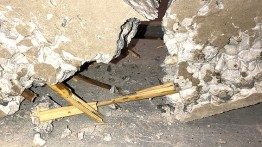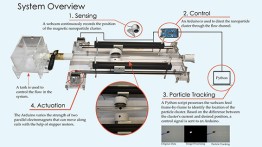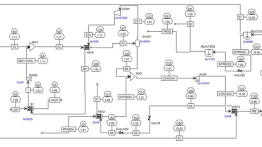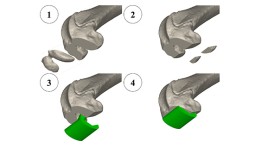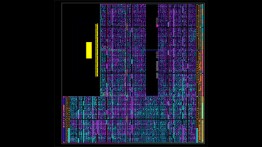Senior Snapshots 2018: Engineering
POSTED ON: May 22, 2018
In the third and final installment of our annual series we catch up with seven graduating seniors and one graduated "senior" from the Albert Nerken School of Engineering. Some seniors have been working together on various teams for some time, so we decided to pair them.
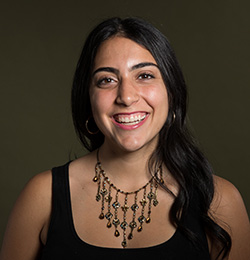 A shared passion for the built environment brought both Arielle Mayourian and Andrew Peña, graduating civil engineering students, to The Cooper Union. Both describe their feelings about buildings as ‘love.’ Their fervor translated well in the classroom. Arielle and Andrew are graduating with high marks and have their next steps planned out—a dream industry job for her and graduate school at UC Berkeley for him.
A shared passion for the built environment brought both Arielle Mayourian and Andrew Peña, graduating civil engineering students, to The Cooper Union. Both describe their feelings about buildings as ‘love.’ Their fervor translated well in the classroom. Arielle and Andrew are graduating with high marks and have their next steps planned out—a dream industry job for her and graduate school at UC Berkeley for him.
For Arielle, who attended nearby Roslyn High School in Long Island, the decision to apply to The Cooper Union wasn’t difficult. It was whether to apply for engineering or architecture. “I ultimately decided to apply for civil engineering as I thought that would provide me a broader education and would open up opportunities in many different types of fields,” she says. Her older brother Josh graduated from Cooper with a chemical engineering degree in 2014, but he gave her no tips, advice or warnings about the workload she would face. “It allowed me to create my own story,” she says.
Andrew credits a friend’s dad, a partner at an engineering firm, for introducing him to the civil engineering profession. Andrew was allowed to tag along to various project sites as a kid, notably the rehabilitation of the Alexander Hamilton bridge over the Harlem River. Andrew grew up nearby in Bergen County, New Jersey where he attended Northern Valley Regional High School at Demarest. When the time came to apply for college, Cooper Union had everything he wanted—an intimate student body, a location close to home but in a city with great opportunity, and a strong engineering program. He applied shortly after the decision to charge tuition was announced, but he says it didn’t change his mind. “Cooper was still the best option for me.”
During their time at Cooper, Arielle and Andrew’s shared many group efforts, from winning their first design project —constructing a six-foot-scale bridge with a precise yield point—to their final capstone project where they designed a multi-building community center complex in Astoria, Queens. This last proposal included site surveys, cost analysis, and geotechnical, structural, water, and environmental system designs. “The only thing we didn’t do was actually construct the buildings,” Andrew says.
 However, it was their senior experimental project that both considered one of the most rewarding experiences. The group created an experiment to determine whether or not bamboo culms (rods), an easily accessible and highly versatile material, would add strength to a concrete beam or weaken it. “It was an invaluable experience,” Arielle says. “We were able to create and carry out a project that originated from our desire to experiment with different orientations and cuts of bamboo in order to determine its most ideal use as a replacement for steel rebar in places where steel cannot be as easily produced.” Generally speaking, they found that bamboo increased strength and ductility of the concrete beams and that adding an adhesive coating made it even more effective.
However, it was their senior experimental project that both considered one of the most rewarding experiences. The group created an experiment to determine whether or not bamboo culms (rods), an easily accessible and highly versatile material, would add strength to a concrete beam or weaken it. “It was an invaluable experience,” Arielle says. “We were able to create and carry out a project that originated from our desire to experiment with different orientations and cuts of bamboo in order to determine its most ideal use as a replacement for steel rebar in places where steel cannot be as easily produced.” Generally speaking, they found that bamboo increased strength and ductility of the concrete beams and that adding an adhesive coating made it even more effective.
Arielle’s Cooper education wasn’t limited to the engineering school. She rounded out her degree by taking Crossings and Construction Management in the School of Architecture and 2D drawing in the School of Art. “Professor Goldberg taught me to stop thinking as an engineer and create work that would allow others to feel; perhaps there is room for that in engineering!” The excitement Arielle uses when she describes the built environment proves that she is bringing more than just technical thinking to the profession. She also learned a lot from playing on the basketball team. After realizing she was the most experienced player, even as a freshman, her teammates nicknamed her “the undercover captain.” She became the official captain her junior year. “Even though our team had mostly beginners, I loved playing at Cooper,” she tells us. “Cooper students are quick learners with good heads on their shoulders!”
Andrew has immersed himself into Cooper Union life for the past four years. He lived in the dorm his first year, and then remained as a resident assistant for the last three years. “Being an RA has helped me grow personally. It’s important to be a role model and be able to manage the additional administrative responsibilities. Plus, it was fun to plan programs and events.” He also spent four years as a member of Cooper’s Steel Bridge Team, part of a national competition sponsored by the American Institute of Steel Construction. This year he was a co-captain, and in the midst of studying for finals and completing final projects, he was also practicing almost every night from 9 p.m. until midnight in preparation for the regional competition which took place on May 5.
As they both plan to move on from The Cooper Union, they are well prepared for their respective professional pursuits. Arielle will begin the professional graduate program at Lendlease, an international property and infrastructure group, on June 18. The two-year gig consists of four different site rotations, allowing recent graduates to test their hand at different roles in the firm. She’s excited about her first rotation—a high rise residential building near Columbus Circle. “I am interested in constructing a place that touches people most—a place for people to live,” she says. What will she miss most about her time here? She’s created a comfort zone here over the past four years. “I’ve surrounded myself with supportive people who challenge each other to be the best versions of themselves,” she says.
As for Andrew, his traditional civil engineering internship and experience at a tech start-up exposed him to different sides of the industry and inspired him to capitalize on this background. He begins the Engineering and Project Management Master’s program at UC Berkeley this fall to expand his skillset. This summer he also plans to do a deep dive into programming, either through a coding boot camp or tutorials online. “I want to comprehensively understand both the technology and the construction aspects. Ideally, I would be able to conceive a technological solution, do the programming, and know how to best implement the system,” he tells us. “One of my professional goals is to establish an A/E/C-focused consultancy that assists designers, contractors, and owners in managing technology and business practices to enable the successful delivery of any construction project.
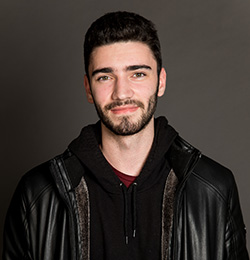 For some people, professional pursuits run in their blood. That’s the case for Cristian Lacey, who will earn his bachelor’s in mechanical engineering this month. Both his grandfather and father were engineers for ExxonMobil. His skills extend beyond his genes—he finished with a 3.98 GPA and will be attending Princeton University in the fall for his PhD.
For some people, professional pursuits run in their blood. That’s the case for Cristian Lacey, who will earn his bachelor’s in mechanical engineering this month. Both his grandfather and father were engineers for ExxonMobil. His skills extend beyond his genes—he finished with a 3.98 GPA and will be attending Princeton University in the fall for his PhD.
Cristian’s father’s career as a naval architect and ocean engineer took the family from Houston, Texas to Doha, Qatar, and eventually Newfoundland, Canada, where Cristian attended high school at St. Bonaventure’s College. After his father retired, the family settled in West New York, New Jersey. “I chose mechanical engineering basically by a process of elimination,” he says. He wasn’t interested in chemical or civil engineering, and though he did like aspects of electrical engineering, his interest in physical modeling led him to study mechanical.
The classes he preferred at Cooper involved hands-on work, in particular, his Digital Logic Design class. “There was no hand-holding. We were assigned a large project and we had to figure it out,” he says. Cristian also became hooked on the study of computational fluid dynamics (CFD) in a course with Professor Scott Bondi, an adjunct instructor who is an associate principal at the firm Simpson Gumpertz & Heger. Rather than just focusing on the theory of CFD, which is the science of using mathematical equations to predict fluid flow, heat transfer, mass transfer, chemical reactions, and related phenomena, the course taught him how to apply the software. “It’s helpful for solving problems that won’t have an exact solution. Those are the more realistic problems,” he tells us. “It’s currently a limited tool but has a powerful future and I’m looking forward to studying it more.”
For their capstone mechanical engineering project, Cristian’s team investigated the feasibility of using electromagnets for targeted drug delivery. Currently, cancer treatment methods harm far more healthy cells than tumor cells. Researchers can bind chemotherapy drugs to magnetic nanoparticles, allowing treatment to be administered to tumor cells in a more focused manner. Yet a system to control the motion of the magnetic nanoparticles has yet to be developed. Cristian’s team created an external control system that directs and holds a nanoparticle cluster in a solution. The system can sense the position of the cluster, track the difference between the current and desired position, and then vary the strength of two parallel electromagnets to direct it toward a target. “Though our research is currently several steps removed from a commercial product, I hope that future Cooper students continue with the project and aid in that transition,” he says.
He worked as an intern for Smith Engineering, a firm headquartered in New York City, over the past year. But otherwise, his time at Cooper was focused on academics. Cristian identifies one of his biggest challenges as a student came sophomore year, when he decided to commute from home in New Jersey which limited his study time. “I just spent a lot of time in the classroom,” he says. “If you don’t procrastinate and manage your time well, you can get all of your work done.”
This fall, Cristian will continue his studies at Princeton’s School of Engineering and Applied Science. He received the Gordon Y. S. Wu Fellowship in Engineering, a selective and prestigious award that will provide him full tuition and stipend support. It was his first choice. Though his academic achievements certainly made his application stand out, he credits the Center for Writing at Cooper for helping him through his personal statement. “They were very useful and I encourage anyone thinking of graduate school to use the service. I went to the writing center a lot throughout school.” There will be one familiar face in his graduate cohort of six Ph.D. candidates: fellow Cooper alumnus Alex Novoselov ME’15. He’s unsure of his end goal, but imagines it will be something research centric.
Cristian admits he’s a little ambivalent about New York City, so isn’t devastated to leave. But he will miss the ease of obtaining delicious Mexican food outside his doorstep (Downtown Bakery is a favorite). He will also miss the people he has met at Cooper. The small school atmosphere has allowed him to develop great relationships with fellow students and professors. Princeton was attractive for that same reason; he is looking forward to a traditional campus setting.
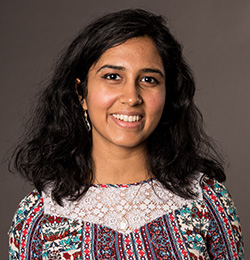 Though they hail from wildly different backgrounds Daniel Galperin and Anushree Sreedhar have led remarkably parallel lives since arriving at The Cooper Union, not only because they are both seniors in the chemical engineering department, but outside of their studies. Anushree arrived in Queens from the Seychelles, after being born in Mumbai, India. Later she moved to New Jersey and attended J.P. Stevens High School in Edison. She first spotted Cooper Union from a car window while her older sister investigated NYU. Daniel's Cooper story is like Anushree's, but in reverse. He was born in New York City but then moved at age 10 to Moscow, his parent's first home, where he spent his teenage years. He knew he wanted to return to New York for college and found out about The Cooper Union through a family friend.
Though they hail from wildly different backgrounds Daniel Galperin and Anushree Sreedhar have led remarkably parallel lives since arriving at The Cooper Union, not only because they are both seniors in the chemical engineering department, but outside of their studies. Anushree arrived in Queens from the Seychelles, after being born in Mumbai, India. Later she moved to New Jersey and attended J.P. Stevens High School in Edison. She first spotted Cooper Union from a car window while her older sister investigated NYU. Daniel's Cooper story is like Anushree's, but in reverse. He was born in New York City but then moved at age 10 to Moscow, his parent's first home, where he spent his teenage years. He knew he wanted to return to New York for college and found out about The Cooper Union through a family friend.
"I focused on chemical engineering the way most chemical engineers start out, as I understand it." Daniel says. "They are good at chemistry and math in high school and I think, 'Obviously, that means chemical engineering.' They don't know that it's actually more about physics and math but, that was how I got here and lucky for me I actually liked it." Anushree, who also excelled at high school math and chemistry, concurs. "My best piece of advice I can give to anyone thinking of studying chemical engineering is, 'Talk to a real chemical engineer.' Talk to someone who has been through the process. Luckily it starts out with a lot of chemistry but then it turns more process-based. But you can customize at Cooper as you see fit. You can do research, try new things."
Trying new things has been Anushree and Daniel's by-words during their time at school. "I've been part of a lot of clubs," Anushree says. She's not kidding. She is a founding member of the school's chapter of Society of Asian Scientists and Engineering. As a freshman, she joined the Cooper chapter of the American Institute for Chemical Engineers, of which she is now president. She also joined the Society of Women Engineers (founded at Cooper!) and two different musical ensembles. Outside of all that she was a lead organizer of the Cooper-centric TEDx event held in the Great Hall in 2017.
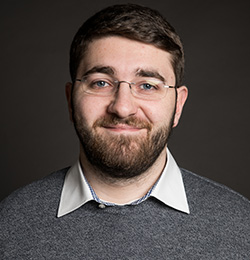 For his part Daniel says, "If I wasn't a chemical engineering student I would be studying theater." So, he joined the Cooper Dramatic Society early on, eventually directing a play. But he credits his work as part of the Engineering Joint Student Council as the most important experience. "If I am lucky enough to get a management position I would credit it to what I learned in Joint Student Council, hands down." Hmmm. What else? Oh yes, Daniel and Anushree were both participants in the 2015 Invention Factory (Anushree and her partner won second place) and they both worked on the student paper.
For his part Daniel says, "If I wasn't a chemical engineering student I would be studying theater." So, he joined the Cooper Dramatic Society early on, eventually directing a play. But he credits his work as part of the Engineering Joint Student Council as the most important experience. "If I am lucky enough to get a management position I would credit it to what I learned in Joint Student Council, hands down." Hmmm. What else? Oh yes, Daniel and Anushree were both participants in the 2015 Invention Factory (Anushree and her partner won second place) and they both worked on the student paper.
Meanwhile, they studied chemical engineering. Now they find themselves on the same team as part of the group-based senior "capstone" project. This year they must design and make the business case for a production plant that would make nylon 6,6, a polymer used most commonly in textiles and the automotive industry. There are four people on the team. Two members, including Daniel, manage the design of the process using simulations they learned. Then there's the peripheral factors, that are more business end, that Anushree and her partner examine. "The process for making nylon 6,6 hasn't changed in 80 years," Anushree says. "So the actual chemistry part we don't focus on so much because it's already been done. We focus instead on how do we optimize our costs? Who are we selling it to? How much are we selling? How many people will work there? What will the layout be? How much for land and where?"
This works out because Anushree turned her attentions more to the data and business end of chemical engineering spectrum while Dan specializes in the nitty-gritty details of process. As a result, after graduating she will begin working for Accenture, a management consulting firm. "I didn't know what I wanted to settle into, so I thought consulting would be a way to go," she says. "I have a lot of interest in the finance industry, in healthcare, in government. So hopefully I will learn more about those." Daniel will be doing pretty much the opposite when he starts work at Watts Water Technologies, makers of plumbing, heating, and water quality solutions. "I know it doesn't sound interesting but to me it is fascinating," Daniel says. "For example, the boiler market today is relatively undiversified. All of the products are relatively substitutable. If an engineer can come up with even the slightest incremental change to advance the boiler technology, that would be huge. There are many small and super-specific improvements that can be made and that’s where I live. I love that super-specificity."
Among the many things that Daniel and Anushree share in their Cooper experience, you can add mixed feelings about being part of the first class to graduate under the new tuition policy. "Overall I think the school is heading in a good direction," Anushree says. "I am glad to have been part of the school during a time it was moving forward and being progressive. I hope people take the time to self-reflect on what Cooper has done for them. I hope they think about paying it forward because that is your good Karma." Daniel adds, "There is sentiment we hear, varying from school to school, 'Why would I donate later? My tuition is my donation' and personally I disagree. I think education has cost and someone needs to bear it. Unfortunately, we are bearing it now but someone's got to pay for it. But just wait till I get my hands on some money. I am donating for sure. This education is the most valuable thing anyone has ever given me. I can't pay enough money back to equal that."
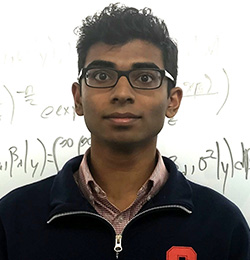 Arvinth Sethuraman is perhaps the most nontraditional senior snapshot, beginning with the fact that he has never considered himself a ‘senior,’ per se. He finished his bachelor’s degree in December 2017 in only two and a half years. He is already a semester into his graduate work at Cornell University.
Arvinth Sethuraman is perhaps the most nontraditional senior snapshot, beginning with the fact that he has never considered himself a ‘senior,’ per se. He finished his bachelor’s degree in December 2017 in only two and a half years. He is already a semester into his graduate work at Cornell University.
Raised in New Jersey, he excelled in math and science from the start at Westminster Plainsboro High School North. His dad worked in the city and he set his sights on The Cooper Union from an early age. After visiting and sitting in on Professor Ben Davis’s course, Math Techniques for Chemical Engineers, he was hooked on learning the optimization and problem solving aspects of engineering. Cooper Union was the only engineering school he applied to; he was admitted and enrolled as a chemical engineer in the fall of 2015.
After his Engineering Design and Problem Solving course his first semester, his interests began to shift. Under the direction of Professor David Wootton, his group was charged with developing an exercise device for patients at a non-profit pediatrics clinic in the Bronx. Arvinth and his classmates predicted the patients would be interested in devices that created an interactive experience and were fun to operate. But to their surprise, the kids valued affordability and portability instead. “That was when I learned that this project wasn’t just about engineering, but about serving a community.” His team retrofitted a rowing machine, that had a low enough profile to be stored underneath a bed, with a shaft encoder that directly translates exercise into visual progress via an attached monitor.
This exposure to the field of biomedical engineering caused him to instead pursue a general bachelor’s degree in engineering. It allowed him to continue taking mostly chemical engineering classes, especially those related to biomedical engineering, but omit the more industrial classes and add some mechanical engineering courses. How did he manage to graduate in only five semesters? “I came into Cooper with credits from high school, placing out of organic chemistry, math, and physics. Then I took an average of 22 credits each semester,” he says. “The last semester I took 24 credits. I knew I wanted to finish.”
Arvinth calculated that he worked about 120 hours a week in classes, on homework, in the lab, or other activities. He balanced a part-time job at the Hospital for Special Surgery, working under Dr. Mathias Bostrom and his team of physician-scientists on how to improve bone healing through pharmacologic therapies like anti-resorptives and anabolic hormones. “A typical day for me was getting to the hospital by 5 a.m., having meetings and doing work until I went back downtown for an 11 a.m. class, class until 9 p.m., then student council meeting. I always operated at 100%”
He began a one-year master’s program in biomedical engineering at Cornell University this January. “I needed to learn more specific biomedical knowledge after my foundation in engineering Cooper,” he explains. He hopes to next pursue his MD. In fact, you could say Arvinth always has his next step planned. He received a Fulbright Award last year which he will use after he graduates from Cornell. Arvinth will spend the first nine months of 2019 in Coimbatore, India, working under the head of a major hospital. “We will be exploring how to discern which patients will benefit from pharmaceutical intervention, so we can selectively prescribe these agents to them and not others where the agents might not work as well." Ultimately, his goal is to translate research into improved clinical models that take factors of everyday life into account. “This grant is really to develop a person,” he says. “I’m looking forward to figuring out what I want to do after it.”
Will he return to walk at graduation? “I hope to come back and walk in 2019 since that’s the class I started with,” he says.
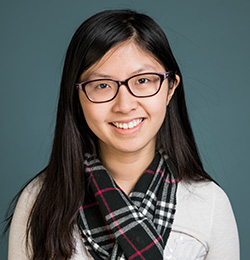 Brenda So and Cory Nezin, both graduating seniors in the electrical engineering program, sure do love their chosen discipline. Last year when Brenda So attended Def Con, a huge hacking and cyber security conference held in Las Vegas, a colleague suggested they that since they were there, they might as well add one more thing to their schedule of three days of talks and demonstrations. “My friend said, let’s get our ham radio license. And I thought, well, I’m here, why not?” So, foregoing a Celine Dion concert or a day at the slots, Brenda sat for her entry-level ham radio license. “It lets you transmit on certain bands, but not all,” she points out.
Brenda So and Cory Nezin, both graduating seniors in the electrical engineering program, sure do love their chosen discipline. Last year when Brenda So attended Def Con, a huge hacking and cyber security conference held in Las Vegas, a colleague suggested they that since they were there, they might as well add one more thing to their schedule of three days of talks and demonstrations. “My friend said, let’s get our ham radio license. And I thought, well, I’m here, why not?” So, foregoing a Celine Dion concert or a day at the slots, Brenda sat for her entry-level ham radio license. “It lets you transmit on certain bands, but not all,” she points out.
Cory Nezin, Brenda’s senior project partner, it’s safe to say, is equally steeped in all things electrical engineering. For one thing, Cory, a native of Freeport, Long Island, earned his master's in the field at the same time as he was completing his undergraduate course work. He says the most influential course he took during his four years at The Cooper Union was EID 101, a course taught by Professor Toby Cumberbatch, for which Cory’s class built RAMESSES II, a dome-shaped shelter that could be made of inexpensive, local materials for refugees in sub-Saharan Africa. That course demonstrated to Cory that all the abstraction of engineering calculations could have a very real impact on the world. At the same time, he recognized that drawing from different fields could be a great source for advances in electrical engineering.
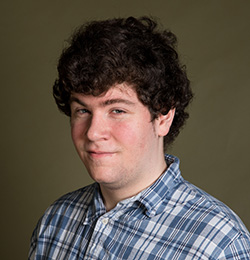 Take, for example, the way that he and Brenda, a graduate of Li Po Chun United World College in Hong Kong, came up with their senior project. As students in their first-year course, Digital Logic Design, they learned about logic gates, a building block for an element that would play a critical role in their senior project. For that research, Brenda and Cory, both of whom arrived at Cooper thinking they would study civil engineering, decided to design electronics for communication that could cover a wide area while using little energy. Specifically, they were thinking about soldiers on battlefields needing both to find available networks for communication, and the ability to identify and jam those of enemy troops. In part, this idea came about as a result of Cory’s internship at the Lincoln Lab at MIT where radar defense research is conducted.
Take, for example, the way that he and Brenda, a graduate of Li Po Chun United World College in Hong Kong, came up with their senior project. As students in their first-year course, Digital Logic Design, they learned about logic gates, a building block for an element that would play a critical role in their senior project. For that research, Brenda and Cory, both of whom arrived at Cooper thinking they would study civil engineering, decided to design electronics for communication that could cover a wide area while using little energy. Specifically, they were thinking about soldiers on battlefields needing both to find available networks for communication, and the ability to identify and jam those of enemy troops. In part, this idea came about as a result of Cory’s internship at the Lincoln Lab at MIT where radar defense research is conducted.
The two engineers reasoned that since the popular networks known as convolutional neural networks (CNN’s) have proved highly useful in the areas of artificial intelligence and machine learning, they could also make communication networks far more efficient. The problem, though, is that CNN’s have traditionally been implemented using Graphic Processing Units (GPU’s)—a means for processing complex data with very throughput. But since Brenda and Cory envisioned CNN’s being used for communication electronics, they knew that GPU’s weren’t a realistic option since they require great power and have a higher latency—that is, amount of time needed for computation. Their solution was to run the CNN’s using Field Programmable Gate Arrays (FPGAs), a circuit system that can be programmed and is faster and uses less power than GPU’s. The challenge then was not programming software but hardware, a daunting task that took them seven months to accomplish, much of that time spent debugging their algorithm. But they did manage to design a neural network that is 70 times better latency and uses at least 20 times less power than it would using GPU’s.
This past March their paper about their results took first place in the IEEE’s Region 1 student paper competition. They’re hoping to publish their results in the near future. The two have already published a paper, along with Vishnu Kaimal EE’18 and three professors, about estimating solar panel capacity using satellite images.
Outside of her school work, Brenda was pleased to help organize a TedX talk in spring of 2017. Entitled “One,” the event featured speakers such as Professor Cumberbatch, alumna and EpiBone founder Nina Tandon, architecture professor David Gersten, and volunteers with a group helping secure the safety of refugees crossing the Aegean. The conference was a highlight of Brenda’s years at Cooper, along with participating in HackCooper 2016, a 24-hour hackathon, and Invention Factory in the summer of 2015 where she and her partner Zachary Xing designed a resuscitation aid that would prevent damage to a patient’s rib cage.
After graduation, they both plan to stay in New York, with Cory working for Bloomberg LP as a software engineer, and Brenda heading to Red Balloon Security as a research scientist; she formerly interned with the cybersecurity firm, whose company web site is replete with imagery reminiscent of 1960s British spy dramas. “It’s an exciting place and the work should be pretty challenging.”
Cory, who says his work ethic improved greatly while at Cooper, says of the work load: “It’s a real test of how far you can go.” Both he and Brenda note that the school’s atmosphere is competitive but with a lot of collaboration among students too.
After two semesters of working on hardware design, Cory flashes a broad smile, shakes his head, and says he definitely wants to focus on designing software. “Hardware design—that’s really tough, though I might go back to it one day.”

